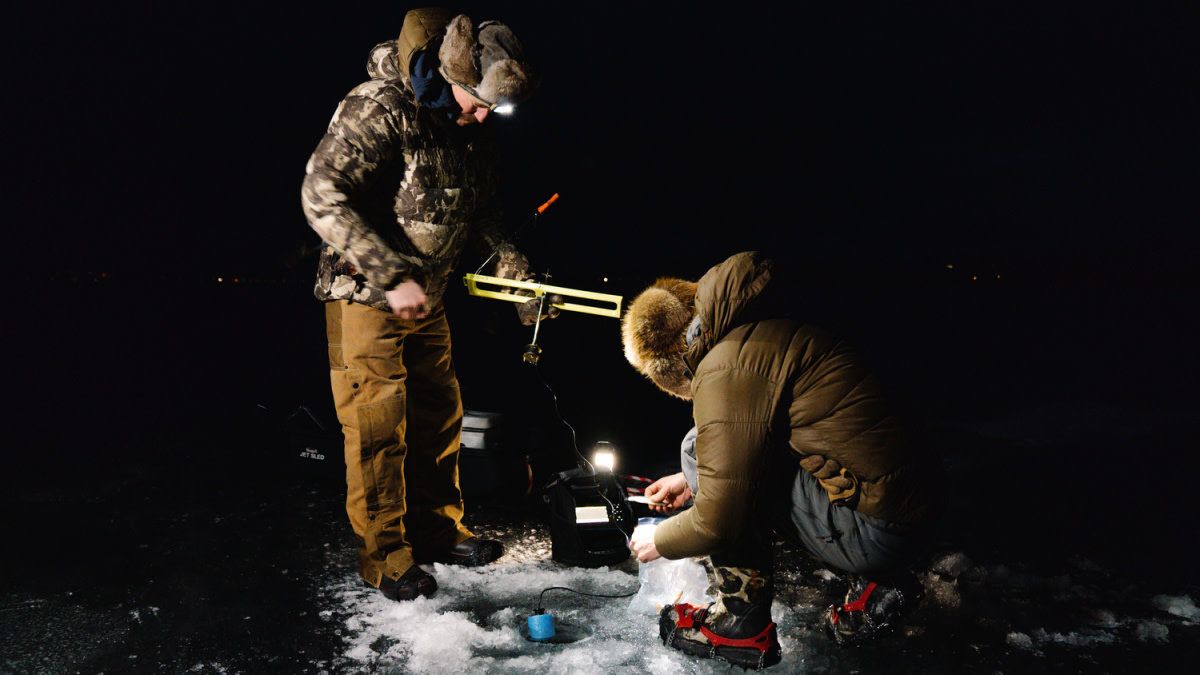
We’ve all seen that guy at the boat launch floating away from the dock with a dead starter battery. The same scenario plays out in a different way when it comes to ice prep—maybe it’s a dead snowmobile or an auger that just won’t start or fishing line that’s seen too much UV.
Most of us pile our ice gear in some corner of the garage after the season is over and we don’t see or think about it until it’s too late in the season that follows. Here are five steps to help you catch more fish, break less gear, and keep cussing to a minimum.
Hit the Open Water Make time during the fall and early winter to get your boat on whatever lakes you’ll be ice fishing. Small bodies of water that aren’t digitally mapped often don’t see as much pressure and can be real sleepers come winter. Something as simple as hitting a few waypoints on your GPS with humps, deep breaks, or other late season hotspots will save you a lot of extra drilling in a few months.
You can take it one step further and use technology like Humminbird’s Auto Chart Live, which allows you to make a custom map of your small waterway and save it either to the unit or an SD card. This simple step will save you a lot of time and drastically improve your winter efficiency.
Map it Out Last year I headed 2,100 miles west to Idaho with the hope of landing some sumo perch. With little intel and a few rookie ice anglers tagging along, I knew I needed either luck or another factor to put the odds in my favor. Instead of relying on luck, I spent an hour each night leading up to the trip studying the digital map on my 12-inch Humminbird Helix unit from the living room.
An extra power cord hooked to a small battery works wonders for doing research from the comfort of your couch. Just don’t wait until the last minute: This can take more time than you think. The map will show more or less detail as you zoom in or out, and the extra details I picked up from zooming way, way in made all the difference in our trip. I dropped an icon on two spots and they ended up being exactly where we caught the majority of our big fish. It may seem crazy, but you won’t see these little details while riding on a snowmobile in the dark.
Check the Fuel Bad fuel is a big problem in everything from boats to weedwhackers. Ice fishing gear is no different. I prefer to store my snowmobile with a full tank of non-ethanol gas, but I often end up siphoning it out before firing up the engine and put the older fuel in my truck instead. No matter what, gas loses octane over time, and fresher is always better. Filling your machine over the summer helps cut down on moisture in the tank, and that relatively small amount of old gas won’t affect your vehicle like it would a smaller engine. The few extra bucks you spend with the premium fuel is likely to save you a much larger bill at the mechanic.
The same can be said for gas augers. I choose to run premixed fuel, which combines just the right amount of oil with stabilizers. These small cans cost a little more, but the peace of mind and convenience are well worth it.
Charge the Batteries We have way more battery options today than we did just a few years ago. Wet cell, AGM, and lithium ion all have their time and place. Regardless of which one you use, it’s a good idea to charge them at least once over the summer and again before use in the winter. Traditional wet cell batteries lose more charge than AGM and lithium batteries over time and require a closer eye. On large starter batteries, keeping a quality battery tender hooked up year-round is a wise choice.
Don’t overlook checking on headlamps, electronics, heaters, or any other battery-powered tool you rely on for fishing when the temps dip. We’ve all discovered headlamps filled with what looks like sand but is actually just corrosion. Double check everything to make sure it’s ready when you need it.
Start it Up This is a good idea for any machine that isn’t fogged or winterized. Sitting idle can do just as much damage as actual use. If you do have a problem, you need to know well before it’s time to use the equipment again. Don’t be the guy who finds out his snowblower doesn’t work until the first blizzard hits. No one likes paying for appraisals and expedited shipping on new parts.
Gas augers can be temperamental but starting them up a few times prior to the season and letting them run for a while makes a big difference. This is also a good time to replace the spark plug and make sure you have a spare.
Open it Up I had a buddy open his enclosed trailer a few days before an ice trip about five years ago only to realize mice had gotten in and chewed holes in pretty much everything he owned: float suits, shanties, gear bags, you name it. A couple even decided to make a nest in his snow machine’s engine compartment. Do your best to seal up any cracks to keep critters out. Rumor on the street is that dryer sheets and bars of Irish Spring soap help deter these small creators of chaos.
We all know about most of the items on this list, but let’s be honest, we need a reminder if not a kick in the butt at times. These tasks aren’t fun or glamourous, but they are relatively quick, easy, and inexpensive. More importantly, they’ll keep you from ending up dead on the ice.





Conversation